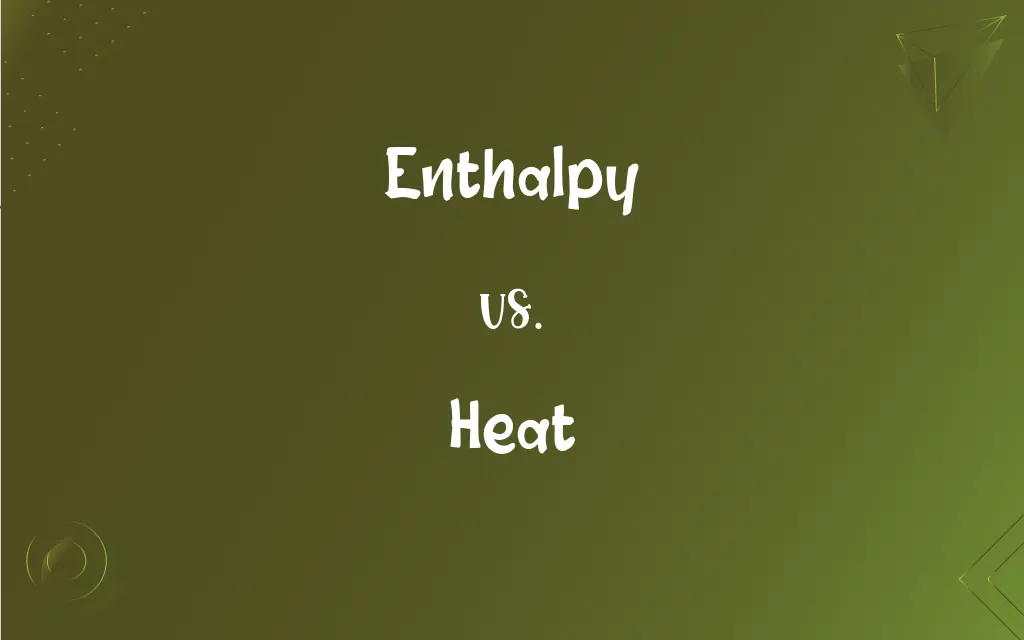Enthalpy vs. Heat: What's the Difference?
Edited by Aimie Carlson || By Janet White || Published on December 2, 2023
Enthalpy is a thermodynamic property representing total heat content in a system, including internal energy and pressure-volume work, while heat is energy transferred due to temperature difference.

Key Differences
Enthalpy, in thermodynamics, is a property of a system encompassing internal energy plus the product of pressure and volume. Heat, on the other hand, is a form of energy transfer that occurs between systems or objects due to a temperature difference.
Enthalpy is measured in units of energy, typically Joules, and is a state function dependent on the state of the system. Heat is also measured in energy units like Joules or calories, but it is not a state function and depends on the process of energy transfer.
Enthalpy is a key concept in understanding chemical and physical processes, such as reactions and phase changes, where it helps determine the energy changes involved. Heat is concerned with the transfer of energy between systems, playing a crucial role in understanding how systems interact thermally.
Changes in enthalpy (∆H) are used to calculate the heat absorbed or released in constant pressure processes, linking the two concepts. However, the heat transferred is not always equal to the change in enthalpy, particularly in non-constant pressure situations.
Enthalpy is a broader concept, representing the total heat content within a system under specific conditions. Heat, in contrast, is specific to the action of energy moving from one place to another due to temperature difference.
ADVERTISEMENT
Comparison Chart
Definition
Total heat content of a system, including internal energy and pressure-volume work
Energy transferred between systems or objects due to temperature difference
Measurement Units
Joules or other energy units
Joules or calories
Thermodynamic Role
Used in calculating energy changes in chemical and physical processes
Concerned with the transfer of energy due to temperature difference
Nature
State function, dependent on the state of the system
Not a state function, depends on the process
Relation to Processes
Represents the total heat content in a system
Specific to energy movement between systems
ADVERTISEMENT
Enthalpy and Heat Definitions
Enthalpy
Enthalpy is the total heat content of a system.
The enthalpy change was measured to understand the reaction's energy requirement.
Heat
Heat is energy transferred due to temperature difference.
Heat flowed from the hot coffee to the cooler surrounding air.
Enthalpy
Enthalpy includes internal energy and the product of volume and pressure.
Calculating enthalpy helps in analyzing steam turbines' efficiency.
Heat
Heat transfer occurs in various forms, such as conduction or radiation.
Heat radiated from the fire, warming the room.
Enthalpy
Enthalpy is important in understanding chemical reactions.
Exothermic reactions exhibit a decrease in enthalpy.
Heat
Heat is not a state function in thermodynamics.
The amount of heat transferred depends on the process path.
Enthalpy
Enthalpy change is used to calculate heat changes in processes.
The enthalpy of vaporization is critical in distillation processes.
Heat
Heat can be measured in Joules or calories.
The heat produced by the burner was measured in calories.
Enthalpy
Enthalpy is a state function in thermodynamics.
The enthalpy of the system was calculated at different temperatures.
Heat
Heat plays a role in phase changes of substances.
Melting ice absorbs heat from its environment.
Enthalpy
Symbol H A thermodynamic function of a system, equivalent to the sum of the internal energy of the system plus the product of its volume multiplied by the pressure exerted on it by its surroundings.
Heat
A form of energy associated with the kinetic energy of atoms or molecules and capable of being transmitted through solid and fluid media by conduction, through fluid media by convection, and through empty space by radiation.
Enthalpy
A measure of the heat content of a chemical or physical system.
, where H is enthalpy, U is internal energy, p is pressure, and V is volume.
Heat
The transfer of energy from one body to another as a result of a difference in temperature or a change in phase.
Enthalpy
(thermodynamics) a thermodynamic quantity equal to the internal energy of a system plus the product of its volume and pressure;
Enthalpy is the amount of energy in a system capable of doing mechanical work
FAQs
How is heat defined?
Heat is the energy transfer between systems or objects due to a temperature difference.
What is enthalpy in simple terms?
Enthalpy is the total heat content of a system, including its internal energy and pressure-volume work.
What units are used to measure heat?
Heat is measured in Joules or calories.
Can heat flow from a cooler to a warmer body?
In natural processes, heat flows from a warmer to a cooler body, not vice versa.
Can enthalpy be directly measured?
Enthalpy itself is not directly measurable; changes in enthalpy are inferred from other measurements.
Is enthalpy a state function?
Yes, enthalpy is a state function, dependent on the state of the system.
How is enthalpy related to phase changes?
Enthalpy changes during phase changes, like melting or boiling, indicating the energy involved.
What does a change in enthalpy indicate in a chemical reaction?
A change in enthalpy indicates the heat absorbed or released during a chemical reaction.
How does pressure affect enthalpy?
Enthalpy changes with pressure, as it includes the product of pressure and volume.
What is specific heat?
Specific heat is the amount of heat per unit mass required to raise the temperature by one degree Celsius.
How is heat capacity related to heat?
Heat capacity is the amount of heat needed to change a substance's temperature by a certain amount.
What is thermal conductivity?
Thermal conductivity is a material's ability to conduct heat.
Can enthalpy change in an isolated system?
In an isolated system, enthalpy can change if internal processes like chemical reactions occur.
What is the difference between heat and temperature?
Heat is energy transfer due to temperature difference, while temperature is a measure of thermal energy within a system.
Is the heat of combustion an example of enthalpy change?
Yes, the heat of combustion is an example of enthalpy change, showing energy released in a reaction.
What is latent heat?
Latent heat is the heat required for a phase change of a substance without a temperature change.
Can enthalpy be negative?
Yes, enthalpy can be negative, indicating a system releases heat.
How does heat affect the state of matter?
Heat can change the state of matter, like melting solids or boiling liquids.
How is heat transferred?
Heat can be transferred through conduction, convection, and radiation.
What is an exothermic process in terms of enthalpy?
An exothermic process is one where the enthalpy decreases, releasing heat to the surroundings.
About Author
Written by
Janet WhiteJanet White has been an esteemed writer and blogger for Difference Wiki. Holding a Master's degree in Science and Medical Journalism from the prestigious Boston University, she has consistently demonstrated her expertise and passion for her field. When she's not immersed in her work, Janet relishes her time exercising, delving into a good book, and cherishing moments with friends and family.
Edited by
Aimie CarlsonAimie Carlson, holding a master's degree in English literature, is a fervent English language enthusiast. She lends her writing talents to Difference Wiki, a prominent website that specializes in comparisons, offering readers insightful analyses that both captivate and inform.







































































